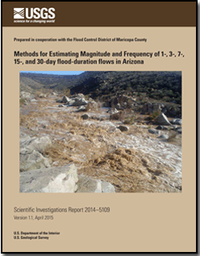Methods for estimating magnitude and frequency of 1-, 3-, 7-, 15-, and 30-day flood-duration flows in Arizona
Links
- More information: USGS Index Page
- Document: Report (11.4 MB pdf)
- Appendixes:
- Download citation as: RIS | Dublin Core
Abstract
Large floods have historically caused extensive damage in Arizona. Although peak-flow frequency estimates are required for managing the risk posed by floods, estimates of the frequency of sustained flood flow (flood-duration flow) are also useful for planning and assessing the adequacy of retention and conveyance structures and for water-resource planning. This report presents a flood-duration flow frequency analysis for selected durations (1 day, 3 day, 7 day, 15 day, and 30 day) at 173 streamgaging stations throughout Arizona and in western New Mexico. For each n-day duration, a log-Pearson type III distribution was fitted to the annual series of n-day flood-duration flows using the expected moments algorithm with a multiple Grubbs-Beck low-outlier test. Regional skews were developed independently for each n-day duration using a hybrid weighted least squares/generalized least squares method. No basin characteristics were found to adequately explain variation in skew among stations and a constant statewide skew model was used for all n-day durations. The regional skewness coefficient is negative for all n-day durations and becomes increasingly negative for longer n-day durations. Uncertainty associated with the skewness coefficient is estimated using a Bayesian generalized least squares technique.
Regression equations, which allow predictions of n-day flood-duration flows for selected annual exceedance probabilities at ungaged sites, were developed using generalized least-squares regression and flood-duration flow frequency estimates at 56 streamgaging stations within a single, relatively uniform physiographic region in the central part of Arizona, between the Colorado Plateau and Basin and Range Province, called the Transition Zone. Drainage area explained most of the variation in the n-day flood-duration annual exceedance probabilities, but mean annual precipitation and mean elevation were also significant variables in the regression models. Standard error of prediction for the regression equations varies from 28 to 53 percent and generally decreases with increasing n-day duration. Outside the Transition Zone there are insufficient streamgaging stations to develop regression equations, but flood-duration flow frequency estimates are presented at select streamgaging stations.
Study Area
| Publication type | Report |
|---|---|
| Publication Subtype | USGS Numbered Series |
| Title | Methods for estimating magnitude and frequency of 1-, 3-, 7-, 15-, and 30-day flood-duration flows in Arizona |
| Series title | Scientific Investigations Report |
| Series number | 2014-5109 |
| DOI | 10.3133/sir20145109 |
| Edition | Version 1.0: December 9, 2014; Version 1.1: April 1, 2015 |
| Year Published | 2014 |
| Language | English |
| Publisher | U.S. Geological Survey |
| Publisher location | Reston, VA |
| Contributing office(s) | Arizona Water Science Center |
| Description | Report: v, 35 p.; 3 Appendices |
| Country | United States |
| State | Arizona |
| Online Only (Y/N) | Y |
| Additional Online Files (Y/N) | Y |


